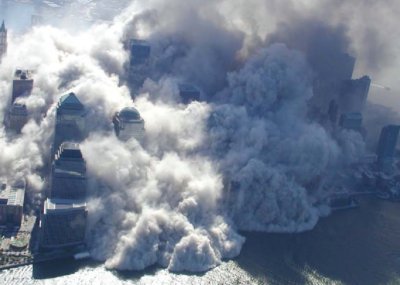"I am glad to reassure the people of New York and Washington, D.C., that their air is safe to breathe and their water is safe to drink." - Christie Whitman, U.S. EPA administrator, September 19, 2001
 It's one thing when people are exposed to hazardous conditions in the heat of a crisis, or because no one is aware of the hazard. In the case of World Trade Center ground zero workers, plenty was known early on about the toxicity of the dust they were inhaling, and little was done to ensure that workers were protected -- especially by those agencies -- the City of New York, OSHA and EPA -- who were responsible for worker safety. One only hopes that, should something like this ever happen again, we've learned our lesson.
It's one thing when people are exposed to hazardous conditions in the heat of a crisis, or because no one is aware of the hazard. In the case of World Trade Center ground zero workers, plenty was known early on about the toxicity of the dust they were inhaling, and little was done to ensure that workers were protected -- especially by those agencies -- the City of New York, OSHA and EPA -- who were responsible for worker safety. One only hopes that, should something like this ever happen again, we've learned our lesson.Now documents and memos obtained by Newsday reveal that New York city officials, pressured by building and business owners to open up downtown New York in the vicinity of the collapsed World Trade Center buildings following 9/11, ignored advice from experts, possibly dooming thousands to illness, shorter lives and death. The documents show that city officials may have opened up hazardous areas prematurely, even though they were warned by other officials at the New York Department of Environmental Protection that the air may have still been hazardous.
The documents revealed that:
- City, state and federal officials failed to enforce workplace safety laws - for example, fining or expelling workers who did not wear respirators. Use of respirators remained below 45 percent for most of the recovery project.
- The city's Department of Environmental Protection, which conducted tests for asbestos in the days immediately after Sept. 11 that showed dangerously high levels of the fibers, did not reveal those test results to the public. The results were later disclosed by the state in response to a Freedom of Information request.
- A U.S. Geological Survey study found that the dust was as caustic as drain cleaner. That study was not disclosed to the public until February 2002.
suggested that the health department should start issuing violations to enforce the safety rules. The idea went nowhere. It wasn't until February 2002 that the city's Department of Design and Construction began to issue fines to companies whose workers disregarded the safety rules, records show.And it's not like the damage showed up years later. Within two months of 9/11, almost 1000 Ground Zero workers reported lung injuries.
Neither McKinney, now with OEM [Office of Environmental Management], nor health department officials responded to a written request for comment.
Early on, the federal, state and local officials running the site decided that the federal Occupational Safety and Health Administration, which enforces workplace safety rules, would only act in an advisory capacity, records show.
Kenneth Holden, the city official in charge of Ground Zero until June 2002, believed that the guidelines in place were sufficient. "We knew that the air quality was less than ideal, but I was also repeatedly and regularly informed that the protection those employees had was sufficient to protect their health," he said in a deposition in the pending class-action suit.
But Ground Zero workers routinely flouted rules requiring the use of respirators. An OSHA summary spanning Sept. 11 to March shows that respirator use among construction workers rarely exceeded 45 percent and was often much lower. The rate among police officers and firefighters was only slightly better.
Safety inspectors who roamed the site consistently reported the failure to use respirators. "We have observed very inconsistent compliance with our recommendations," the EPA's Bruce Sprague warned in an Oct. 5 memo.
On Oct. 15, Stew Burkhammer, an official with Bechtel, the firm initially in charge of safety, complained to city safety official Robert Adams: "They [contractors] are either refusing to take corrective action or are giving our team excuses as to why we have no authority to tell them anything. Our team members are not used to taking abuse like this and are getting very discouraged."
In January and February 2002, the failure to use respirators remained a serious problem. On Jan. 3, for example, DDC official Bruce Rottner wrote that just 20 percent of workers were wearing their respirators.
"Throughout the entire site tonight and last night use of respiratory protective equipment . . . was terrible," Rottner wrote.
There were several reasons for the problems. The masks were difficult to wear. It was hard to breathe and hard to talk in them. And it was a lot to ask workers, on exhausting 12-hour shifts, to wear them at all times, according to memos at the time.
Though OSHA said it had trained thousands of workers, some Ground Zero workers claimed that they either never received respirators or did not receive adequate training in using them.
Several officials have acknowledged in depositions that there was no one person in charge of enforcing the safety guidelines. In hindsight, Sam Benson, a city OEM official, testified: "I certainly would have had more of an overhead team ... and to have a more disciplined process."